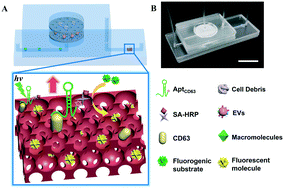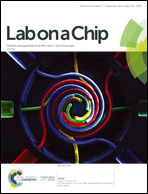Efficient isolation and sensitive quantification of extracellular vesicles based on an integrated ExoID-Chip using photonic crystals†
Abstract
Extracellular vesicles (EVs), involved in many diseases and pathophysiological processes, have emerged as potential biomarkers for cancer diagnosis. However, efficient isolation and detection of EVs still remain challenging. Here, we report an integrated chip for isolation of EVs with a double-filtration unit and ultrasensitive detection using photonic crystal (PC) nanostructure. Nanofiltration membranes were integrated into the device to isolate and enrich the EVs of 20–200 nm in size based on size-exclusion. Then, CD63 aptamers were used to combine the EVs on the nanofiltration membrane with a pore size of 20 nm, and excess aptamers passed through the membrane to bind with CD63 immobilized on the PC nanostructure. Benefitting from the fluorescence enhancement effect of the PC nanostructure in competition assays, the EVs could be quantified sensitively by analyzing the concentration of excess aptamers. Due to the high sensitivity, the limit of detection was as low as 8.9 × 103 EVs per mL with a low sample consumption of only 20 μL. Furthermore, serum samples from breast cancer patients and healthy donors could be successfully distinguished. Thus, this microfluidic chip provides an effective method for pre-screening of cancer in clinical samples.



 Please wait while we load your content...
Please wait while we load your content...